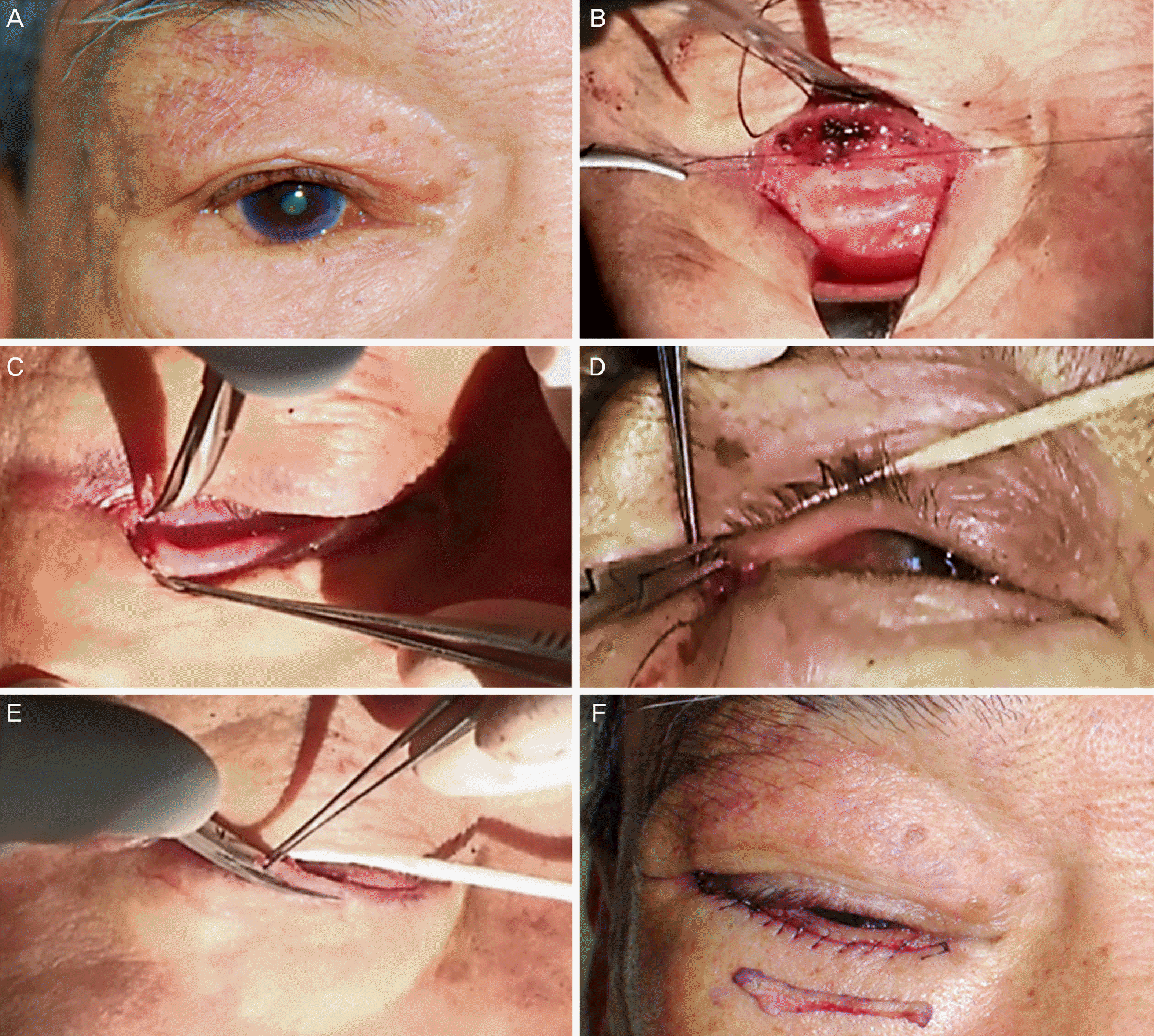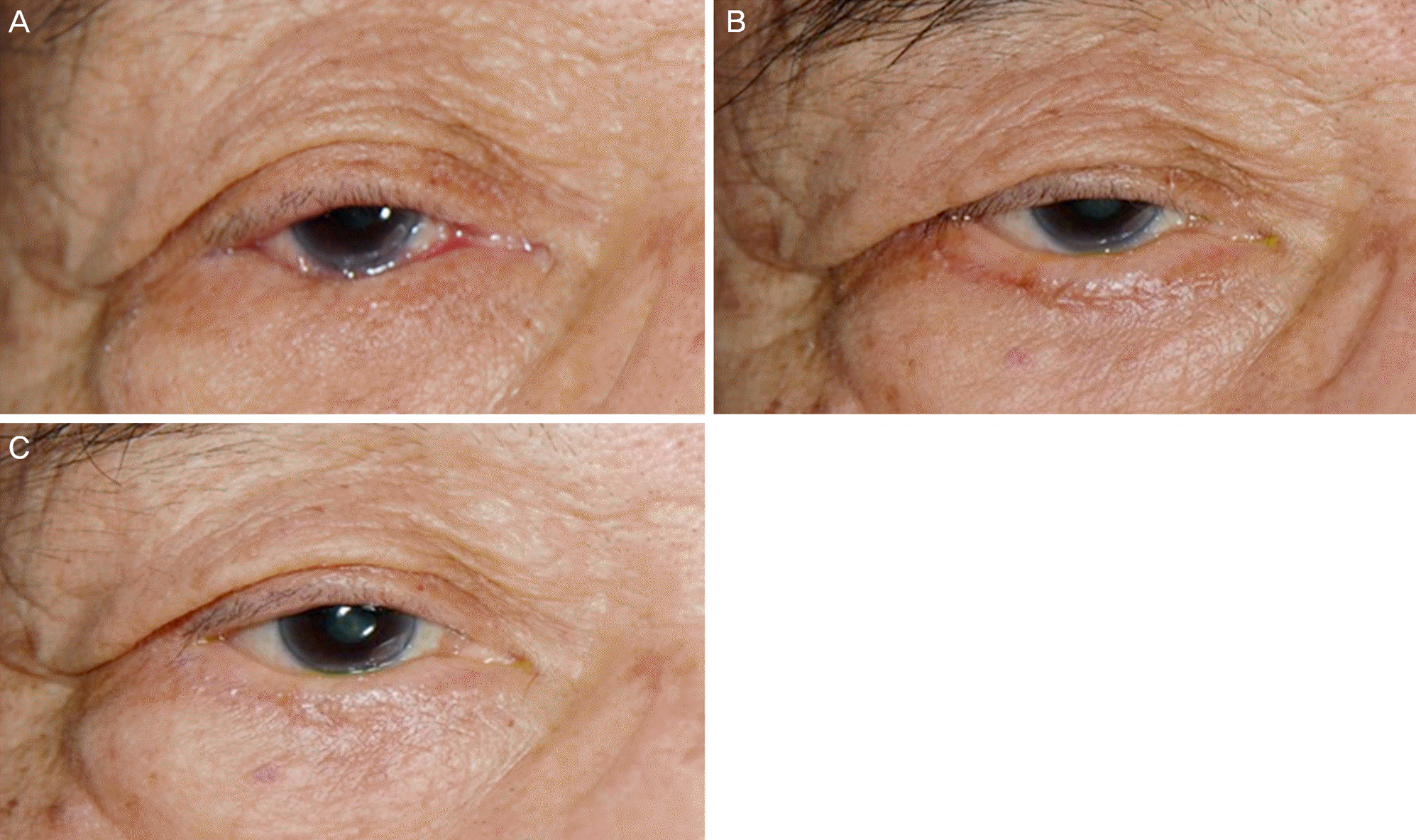Abstract
Purpose
To evaluate the long-term effectiveness of inferior retractor tightening combined with lateral tarsal strip surgery and anterior lamellar resection for simultaneously correcting the 3 main causes of involutional entropion.
Methods
In this retrospective study we reviewed 80 patients diagnosed with involutional entropion between April 2004 and February 2014 at the Korea University Guro Hospital and Cheonan Chungmu Hospital. The patients were evaluated for the 3 major causes of involutional entropion and were confirmed to have all components. Lateral canthal tendon laxity test and anterior lamellar redundancy test were performed to grade the involutional entropion patients. The patients received inferior retractor tightening, lateral tarsal strip operation and anterior lamellar resection procedure simultaneously.
Results
Eighty involutional entropion patients were included in the present study. The patients consisted of 35 males and 45 females with an average age of 71.1 ± 9.3 years. In the lateral canthal tendon laxity test, 52 (61.2%) eyes were grade II, 33 (38.8%) eyes were grade III. In the anterior lamellar redundancy test, 17 (20%) eyes were grade I, 57 (67.1%) eyes were grade II and; 11 (12.9%) eyes were grade III. Among the 80 patients, 85 eyelids received combined surgery, 84 had successful outcomes and 1 case recurred at 5 months following the primary surgery with an average follow up of 26.5 ± 4.6 months. Lateral canthal deformity was observed in 2 eyelids which were corrected successfully.
References
1. Kang S, Park TS, Lee JH, et al. Causes and treatments of entropion and ectropion in adults. J Korean Ophthalmol Soc. 2014; 55:953–7.

2. Yoon JM, Kim SA, Roh JH. Clinical results of different surgical procedures in correcting involutional entropion. J Korean Ophthalmol Soc. 2008; 49:1877–87.

3. Kim SW, Lee WS, Rho JH. Lateral tarsal strip procedure combined with Quickert sutures in correcting involutional entropion. J Korean Ophthalmol Soc. 2012; 53:1213–8.

4. Bashour M, Harvey J. Causes of involutional ectropion and entropion-age-related tarsal changes are the key. Ophthal Plast Reconstr Surg. 2000; 16:131–41.

5. Rougraff PM, Tse DT, Johnson TE, Feuer W. Involutional entropion repair with fornix sutures and lateral tarsal strip procedure. Ophthal Plast Reconstr Surg. 2001; 17:281–7.

6. Serin D, Buttanri IB, Karslioglu S, et al. The efficacy of the combined procedure in involutional entropion surgery: a comparative study. Korean J Ophthalmol. 2013; 27:405–8.

7. Scheepers MA, Singh R, Ng J, et al. A randomized controlled trial comparing everting sutures with everting sutures and a lateral tarsal strip for involutional entropion. Ophthalmology. 2010; 117:352–5.

8. Leibovitch I. Lateral wedge resection: a simple technique for repairing involutional lower eyelid entropion. Dermatol Surg. 2010; 36:1412–8.

9. Lee TE, Lee H, Lee J, Baek S. Medial and lateral canthal tendon laxity: an evaluation of patients with involutional entropion and epiphora. J Korean Ophthalmol Soc. 2011; 52:1385–90.

10. Kocaoglu FA, Katircioglu YA, Tok OY, et al. The histopathology of involutional ectropion and entropion. Can J Ophthalmol. 2009; 44:677–9.

11. Boboridis K, Bunce C, Rose GE. A comparative study of two procedures for repair of involutional lower lid entropion. Ophthalmology. 2000; 107:959–61.

12. Asamura S, Kakizaki H, Shindou E, et al. What is the best strategy for asians with involutional entropion? J Craniofac Surg. 2014; 25:972–5.

13. Wright M, Bell D, Scott C, Leatherbarrow B. Everting suture correction of lower lid involutional entropion. Br J Ophthalmol. 1999; 83:1060–3.

14. Jang SY, Choi SR, Jang JW, et al. Long-term surgical outcomes of Quickert sutures for involutional lower eyelid entropion. J Craniomaxillofac Surg. 2014; 42:1629–31.

15. Ko YJ, Kim HC. Quickert suture using nonabsorbable suture material for lower lid entropion. J Korean Ophthalmol Soc. 2014; 55:1739–44.

16. Ding J, Chen F, Zhai W, et al. Orbicularis oculi muscle transposition for repairing involutional lower eyelid entropion. Graefes Arch Clin Exp Ophthalmol. 2014; 252:1315–8.

17. Olver JM, Barnes JA. Effective small-incision surgery for involutional lower eyelid entropion. Ophthalmology. 2000; 107:1982–8.
18. Rabinovich A, Allard FD, Freitag SK. Lower eyelid involutional entropion repair with lateral tarsal strip and infraciliary rotation sutures: surgical technique and outcomes. Orbit. 2014; 33:184–8.

19. Danks JJ, Rose GE. Involutional lower lid entropion: to shorten or not to shorten? Ophthalmology. 1998; 105:2065–7.
20. Tsang S, Yau GS, Lee JW, et al. Surgical outcome of involutional lower eyelid entropion correction using transcutaneous everting sutures in Chinese patients. Int Ophthalmol. 2014; 34:865–8.

21. Park MS, Chi MJ, Baek SH. Clinical study of single-suture inferior retractor repair for involutional entropion. Ophthalmologica. 2006; 220:327–31.

22. Kreis AJ, Shafi F, Madge SN. Transconjunctival entropion repair – the backdoor approach. Orbit. 2013; 32:271–4.

23. Ahn Y, Kang IS. Correction of involutional entropion by the amount of lower eyelid laxity. J Korean Ophthalmol Soc. 1999; 40:596–602.
24. Jung WS, Jeon SW. Surgical treatment of involutional entropion. J Korean Ophthalmol Soc. 1992; 33:18–22.
Figure 1.
Combined surgery procedure correcting three main causes of involutional entropion: (A) Preoperative photograph. (B) Disinserted inferior retractor is reattached to the inferior margin of the tarsal plate with 6-0 prolene.(C) Lateral canthotomy and cantholysis are perform ed. (D) 4-0 vicryl suture placed in the tarsal strip. (E) Redundant lid skin and muscle tissues are excised. (F) Postoperative photograph.

Figure 2.
Long-term follow up of combined surgery procedure. (A) Preoperative photograph. (B, C) Postoperative photographs (each for 1 month and 6 months after inferior retractor tightening combined with lateral tarsal strip procedure and with anterior lamellar resection).





 PDF
PDF ePub
ePub Citation
Citation Print
Print


 XML Download
XML Download